The Frisians are an ethnic group indigenous to the coastal regions of the Netherlands, northwestern Germany and southern Denmark. They inhabit an area known as Frisia and are concentrated in the Dutch provinces of Friesland and Groningen and, in Germany, East Frisia and North Frisia. The name is probably derived from frisselje. The Frisian languages are spoken by more than 500,000 people; West Frisian is officially recognised in the Netherlands, and North Frisian and Saterland Frisian are recognised as regional languages in Germany.
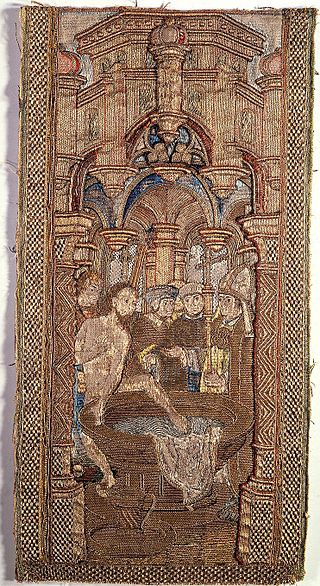
Radbod was the king of Frisia from c. 680 until his death. He is often considered the last independent ruler of Frisia before Frankish domination. He defeated Charles Martel at Cologne. Eventually, Charles prevailed and compelled the Frisians to submit. Radbod died in 719, but for some years his successors struggled against the Frankish power.
"De Alde Friezen" is the anthem of the Friesland province of the Netherlands.
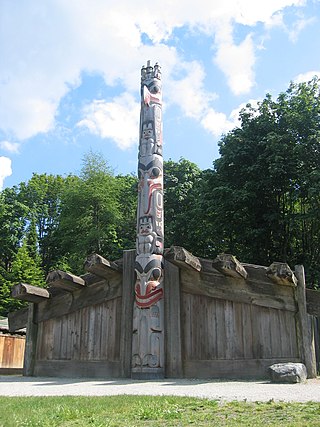
A longhouse or long house is a type of long, proportionately narrow, single-room building for communal dwelling. It has been built in various parts of the world including Asia, Europe, and North America.

The Low German house or Fachhallenhaus is a type of timber-framed farmhouse found in northern Germany and the easternmost Netherlands, which combines living quarters, byre and barn under one roof. It is built as a large hall with bays on the sides for livestock and storage and with the living accommodation at one end.
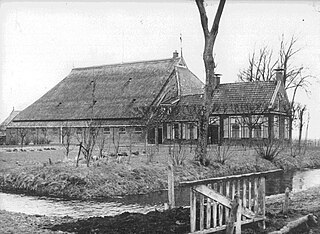
A "Head-Neck-Body farmhouse" or Head-Neck-Rump farmhouse is a typical Frisian farmhouse. It consists of a residence and a kitchen placed in line in front of a big shed. A striking fact is that the residence was never built in the centre front of the shed – this has to do with the origin of this type of farmhouse from a smaller type of farmhouse that has now disappeared. This original Old Frisian longhouse consisted of a residence with a cattle shed immediately behind it. The harvest was stacked in the attic or in open barns which were logically located near the livestock shed.

An Old Frisian farmhouse is a small unit farmhouse (Wohnstallhaus) that combined the farmer's living area and animals' stalls, and had limited space for storing harvest products. It was widely distributed across the North German Plain until the middle of the 17th century and was the forerunner of the Gulf house.

A Gulf house, also called a Gulf farmhouse (Gulfhof) or East Frisian house (Ostfriesenhaus), is a type of byre-dwelling that emerged in the 16th and 17th centuries in North Germany. It is timber-framed and built using post-and-beam construction. Initially Gulf houses appeared in the marshes, but later spread to the Frisian geest. They were distributed across the North Sea coastal regions from West Flanders through the Netherlands, East Frisia and Oldenburg as far as Schleswig-Holstein. This spread was interrupted by the Elbe-Weser Triangle which developed a type of Low German house instead, better known as the Low Saxon house.

A housebarn is a building that is a combination of a house and a barn under the same roof. Most types of housebarn also have room for livestock quarters. If the living quarters are only combined with a byre, whereas the cereals are stored outside the main building, the house is called a byre-dwelling.
The Geestharden house, also called the Cimbrian house, Schleswig house, Slesvig house or Southern Jutland house due to its geographical spread in Jutland, is one of three basic forms on which the many farmhouse types in the north German state of Schleswig-Holstein are based. The other two basic designs are the Gulf house and the Low German hall house. By far the best known variant of the Geestharden house is the Uthland-Frisian house, which is also referred to as the Frisian house (Friesenhaus).
There are several types of Frisian houses in the Netherlands as well as in Germany.
Restaurant De Boerderij is a defunct restaurant in Amsterdam, the Netherlands. It was a fine dining restaurant that was awarded one Michelin star in the periods 1961-1967 and 1980–1985.

A byre-dwelling is a farmhouse in which the living quarters are combined with the livestock and/or grain barn under the same roof. In the latter case, the building is also called a housebarn in American English.
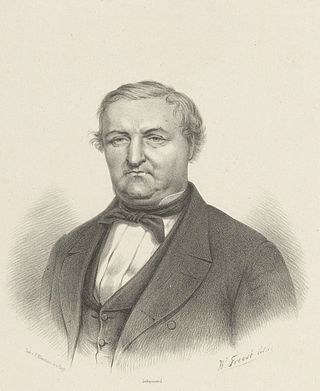
Eeltsje Hiddes Halbertsma was a Frisian writer, poet and physician, and the youngest of the Halbertsma Brothers. He became well known when he and his elder brother Justus published the poetry and short story collection De Lapekoer fan Gabe Skroar in 1822. Afterwards, this work was continually expanded, and also came to include contributions by a third brother, Tsjalling, until all the Halbertsma Brothers' prose and poetry was posthumously collected in 1871 to become the famous work Rimen en Teltsjes. This book played a role of crucial importance in the development of a new literary tradition after Western Frisian had been used almost exclusively as a spoken language for three centuries. Of the three Brothers Halbertsma, Eeltsje was probably the most talented, en his poetry especially is still very much admired. His oeuvre included the poem De Alde Friezen, which later became the national anthem of the Western Frisian people.
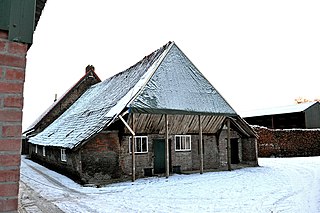
The Armenhoef is a monumental farm on the Oirschotseweg 117 in the North Brabantian town Best in the Netherlands.
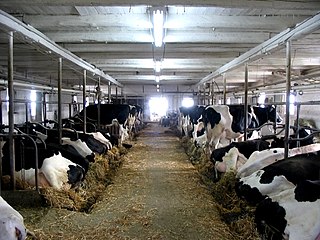
Tie stalls, also known as stanchion or stall barn, are a type of stall where animals are tethered at the neck to their stall. It is mostly used in the dairy industry, although horses might also be stalled in tie stalls. Typical the barn has two rows of stalls, where the cow is tied up for resting, feeding, milking and watering. This type of housing is used in both regular and organic farming.

Justus Hiddes Halbertsma, West Frisian form: Joast Hiddes Halbertsma, pron. [jo.ǝst ˈhɪdəs ˈhɔlbǝtsma] ; Dutch form: Joost Hiddes Halbertsma, pron. [joːst ˈhɪdəs ˈhalbǝrtsma], was a Frisian writer, poet, minister, lexicographer and linguist. Today, he is primarily known for the poetry and short story collection De Lapekoer fan Gabe Skroar, which he wrote with his brother Eeltsje, publishing the first edition in 1822. Afterwards, this work was continually expanded, and also came to include contributions by a third brother, Tsjalling, until all the Halbertsma Brothers' prose and poetry was posthumously collected in 1871 to become the famous work Rimen en Teltsjes. Although the literary value of this collection was later disputed by some critics, it is undeniable that Rimen en Teltsjes played a role of crucial importance in the development of a new literary tradition after Western Frisian had been used almost exclusively as a spoken language for three centuries.

The Brothers Halbertsma were three brothers born in the Frisian village of Grou towards the end of the 18th century, who played a role of crucial importance for the development of a written literature in the Western Frisian language. These three brothers were:

Tsjalling Hiddes Halbertsma, was a Dutch Frisian writer, poet and merchant, and the least well-known of the three Brothers Halbertsma. During his life he won a certain amount of fame in and around Grou, for the poems and short stories he wrote, and also because of his success as a businessman. After his death some of his literary works were collected with those of his brothers Justus and Eeltsje to be published in 1871 as the famous Rimen en Teltsjes. It was only from 1918 onwards that more of Tsjalling Halbertsma's works were added to this collection.

The Ylostins was a Frisian castle or a so-called stins in the city of IJlst, Friesland, Netherlands















